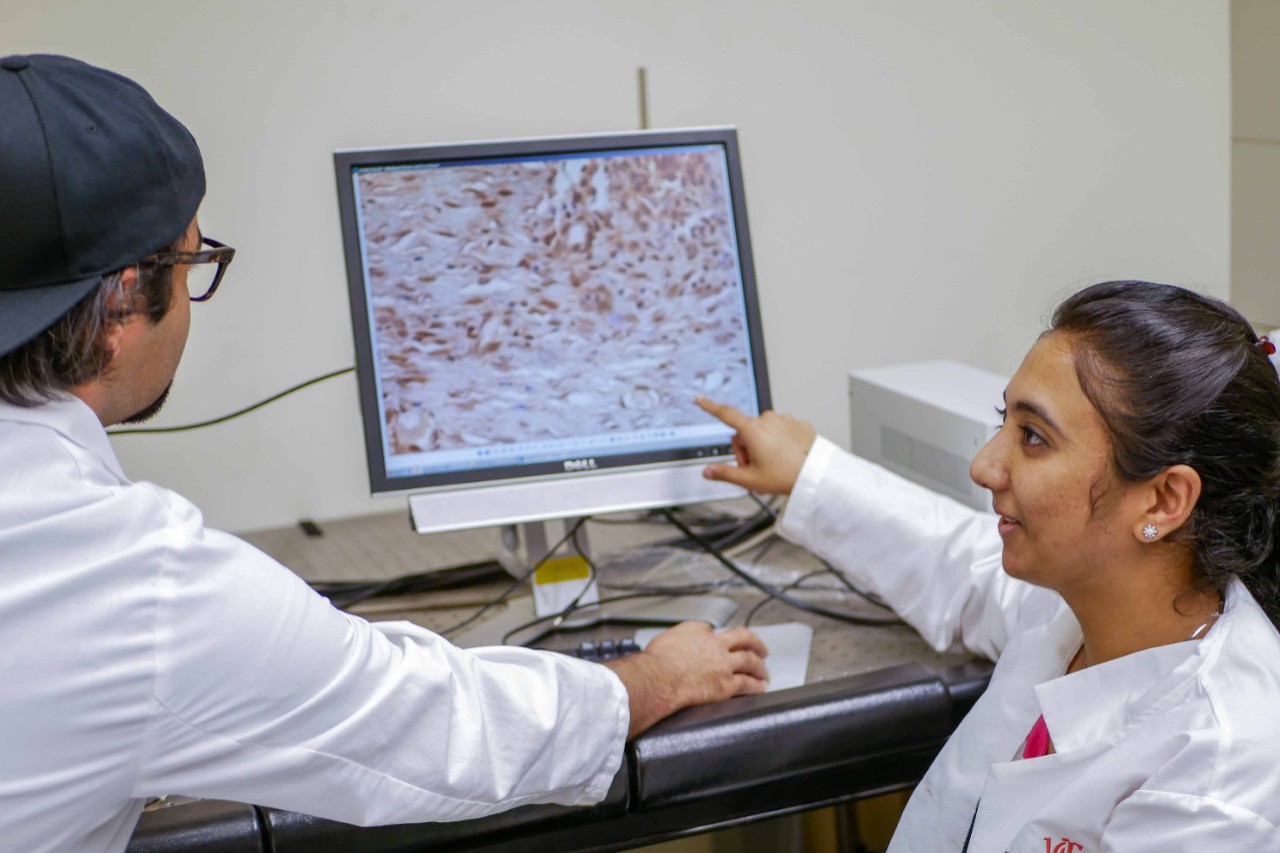
UC researchers use wireless technology to heal wounds
Researchers at the University of Cincinnati are healing wounds wirelessly.
A team of UC researchers invented a noninvasive device that uses high-frequency electric fields, slightly higher than the range emitted from cell phones, to treat diabetic ulcers. They recently received a U.S. patent for the device.
The work reflects UC’s innovation agenda, a platform of the university’s strategic direction, Next Lives Here.

UC Ph.D. candidate in biomedical engineering Nava P. Rijal holds the recently patented device. The team of researchers invented this noninvasive device, which uses high-frequency electric fields to treat diabetic ulcers. Photo/Corrie Stookey/CEAS Marketing
About 15 percent of people with diabetes have diabetic ulcers, chronic wounds that are most common in the foot. These ulcers can start with a small cut and can persist for a long time, because cells affected by diabetes don’t respond quickly enough to heal these wounds. Untreated, the ulcers can cause long-term complications and even lead to amputation.
“We’re not talking about just an inconvenience,” said UC associate professor of biomedical engineering Daria Narmoneva, who is the lead inventor of the device. “People have to live with this for months, sometimes years.”
Narmoneva’s team wanted to create a noninvasive device that was more effective than current treatments, which only work for about 70 percent of people. The research team, which included UC physics professor Andrei Kogan, came up with a device that uses electric waves to trigger the sluggish cells into action.
We’re not talking about just an inconvenience. People have to live with this for months, sometimes years.
Daria Narmoneva, UC associate professor of biomedical engineering

UC Associate Professor of Biomedical Engineering Daria Narmoneva inspects the recently patented device for healing diabetic ulcers. The device uses electric waves to trigger sluggish cells into action. Photo/Corrie Stookey/CEAS Marketing

The UC researchers discuss their recently patented device for treating diabetic ulcers. From left, master's student Vasuretha Chandar, professor Daria Narmoneva and Ph.D. candidate Nava P. Rijal. Photo/Corrie Stookey/CEAS Marketing
“We found that a particular signal very high-frequency signal, 7.5 gigahertz, can have a noticeable effect on the cells as far as activating them,” said Narmoneva. “It boosts the formation of the blood vessels and improves the healing.”
And since the process uses a signal similar to that of a cell phone, it’s is safer than something like a current applied through the skin, which heats up cells and tissue and may damage them.
The team also designed the device to work without touching the wound. Current treatments for diabetic ulcers – whether it be with dressings, pressure, ultrasound therapies or even electrode seals – are all invasive. The electric signals emitted by the device, however, are strong enough to trigger the cells into action, without making physical contact with the wound.
So far, the team has shown that the device repairs tissues even better than current treatments. Now the team is wrapping up preclinical trials and will soon move onto human subjects. They hope to then take the device to market.
“We have some really exciting results,” said Narmoneva. “The healing market is enormous, so the impact here can be great.
Featured image at top: UC biomedical graduate students Nava P. Rijal and Vasuretha Chandar work in the UC Vascular Tissue and Cellular Engineering laboratory. Photo/Corrie Stookey/CEAS Marketing

The UC researchers pose in the Vascular Tissue and Cellular Engineering laboratory. From left, master's student Vasuretha Chandar, Ph.D. candidate Nava P. Rijal, UC professor Daria Narmoneva and UC professor Andrei Kogan. Photo/Corrie Stookey/CEAS Marketing
Next Lives Here
Being the only academic healthcare university in the region is a big responsiblity. See how UC is solving issues related to health and well-being with its strategic direction Next Lives Here.
Related Stories
UC student breaks world record in competitive speedcubing
December 19, 2025
UC computer science student Sujan Feist set a new world record in speedcubing at competition this month in Coshocton, Ohio. Feist is the reigning world champion in the 2x2 division.
Bazinga! UC physicist cracks ‘Big Bang Theory’ problem
December 19, 2025
A physicist at the University of Cincinnati and his colleagues figured out something two of America’s most famous fictional physicists couldn’t: theoretically how to produce subatomic particles called axions in fusion reactors.
Future Tech Forum tackles an AI-driven world
December 19, 2025
Cincinnati innovators and business leaders packed UC’s 1819 Innovation Hub in early December for the Future Tech Forum, where they considered the road ahead for AI.
